Despite the significant cost attached to climbing Everest, hundreds of individuals attempt to summit the mountain every year. Leading to the emergence of stress on waste management and the regions ecosystem. While more climbers bring economic benefits to the region, it also means an increase to the Mount Everest trash problem.
Jamling Tenzing Norgay, son of the legendary Tenzing Norgay who achieved the first ascent of Everest in 1953, expressed deep concern about the issues confronting the region due to the exploding popularity of Everest. Norgay cautioned,
“These activities have created a major ecological problem. They are also evidence of disrespect by the climbing community, and a disregard for nature by those men and women who prioritize their personal conquests over preserving the integrity of this unique environment.”
Jamling Tenzing Norgay
One of the prominent issues highlighted by Norgay is the alarming amount of trash left behind by climbers. Despite our idyllic images of the pristine Himalayas, the reality is that Everest’s snow-covered slopes conceal empty oxygen tanks, wrappers, cans, dead bodies and an assortment of debris.
How Much Trash Is on Mount Everest?
In 2021 the Sagarmatha Pollution Control Committee, a local NGO tasked with waste management in the Everest and Khumbu region, reported the collection of 55,676 kg (122,744 pounds) of waste from Everest Base Camp.
Moreover, the report broke down the type of trash collected and delivered to them by Everest Expeditions. The categories were as follows:
- Burnable garbage – 25,866 kg (around 57,024 pounds)
- Human waste – 22,803 kg (around 50,272 pounds)
- Kitchen waste – 6,079 kg (around 13,401 pounds)
- Nonburnable garbage – 5,291 kg (11,664 pounds)
An additional report by the Everest Summiteers Association in 2019, believes there are still about 30 tons of trash left on Everest. However, this is a conservative estimate, and does not take into account how much garbage has been added to Mount Everest in recent years. Especially since 2023 is shaping up to be the busiest year on Everest.
Trash on Everest – According to National Geographic Estimates:
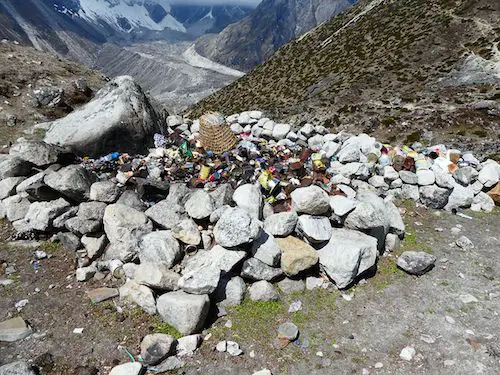
Conservative estimates by the National Geographic Society state that on average, each climber will produce approximately 8 kilograms (about 18 pounds) while on Everest. Therefore, using this estimate, we can project that in 2023, from climbers alone, 3,824 kgs (roughly 8,430 lbs) of trash was produced on Everest. (478 total climbers trying to climb Everest * 8 kg per person).
This estimate balloons when you consider the ratio of sherpas to climbers of 1.5. Meaning that in total during 2023 (as of July 2023), there were approximately 1,200 people on Everest – 9,600 kgs of trash (21,164 lbs).
The estimate of 9,600 kgs of trash being produced on Everest does not take into account two important considerations. One, how much additional garbage is being produced by the expedition teams alone – such as tents, food, medical equipment, human waste (fecal matter and urine), and other gear. The second consideration is we do not know the exact amount being taken off the mountain by climbers, or through additional cleaning projects.
Finally, it is important to consider how much trash is being produced in the larger Khumbu region as well. Whereas, during the almost two week trek to Everest Base Camp, trekkers and climbers are producing waste as they go from village to village. This is alarming, as estimates believe 40,000 climbers make the trek to EBC every year – with 56,303 total climbers visiting Everest Base Camp in 2017.
Photos of the Mount Everest Trash Problem:
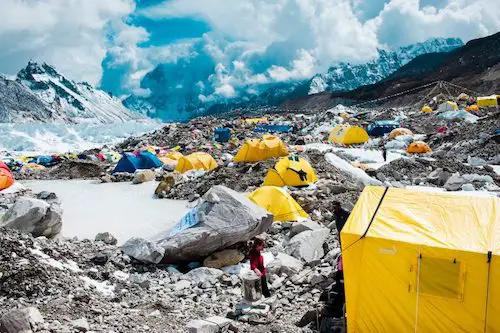

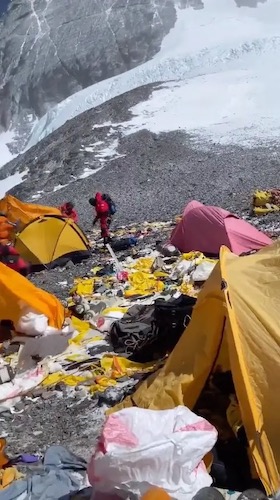
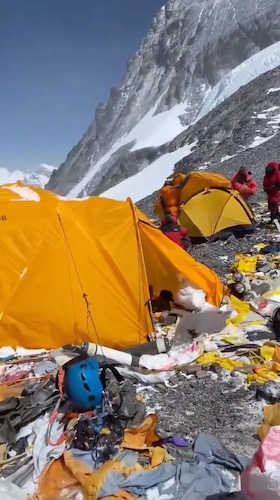
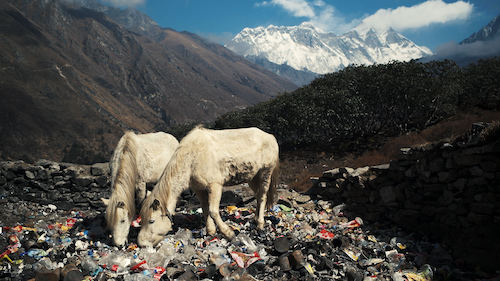
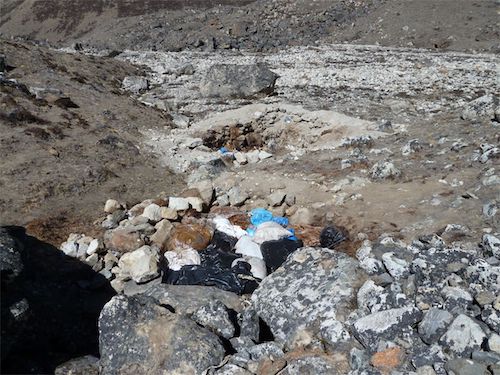
The Everest Trash Problem:
Sagarmatha National Park was established in 1976 with the primary goal of safeguarding the mountain and its wildlife. Recognized for its significance, it earned the distinction of a UNESCO World Heritage site in 1979. However, with approximately 100,000 visitors arriving each year, the park’s natural environment faces considerable strain.
Mount Everest attracts over 600 climbers every season, all attempting to reach the summit during the brief period when weather conditions are favorable. For each climber, there is typically a local Sherpa or guide providing support in various roles.
During their weeks-long stay on Mt. Everest, each climber produces an average of eight kilograms (18 pounds) of trash. Unfortunately, much of this waste is left behind. Discarded oxygen canisters, abandoned tents, food containers, and even human waste litter the slopes. Despite tented toilets available at Base Camp, further up the mountain, climbers have no option but to relieve themselves outdoors. The amount of waste accumulated on the mountain is substantial, whereas research shows that as much as 12,000 kg (26,500 lb) of human poop and urine is left behind on the mountain each season. Compounded with climate change, melting snow and ice, previously concealed garbage and human waste is now becoming exposed.
This environmental crisis poses a severe health risk to the local communities surrounding Mount Everest. The Sagarmatha National Park watershed serves as a crucial water source for thousands of people. However, without proper waste management or sanitation facilities, garbage and sewage are deposited into large pits near local villages, eventually flowing into waterways during the monsoon season. Consequently, the watershed has become contaminated, exposing the locals to dangerous waterborne diseases such as cholera and hepatitis A, caused by water tainted with fecal matter.
Mountaineer Shows Piles of Garbage at Mount Everest in Video:
Video by Tenzi Sherpa showing the amount of trash on Everest in 2023.
Community Solutions Regarding Everest’s Garbage:
In order to assist in the cleanup and resolution of the Mount Everest trash problem, community groups, NGOs and the Nepali Government have come together to clean the mountain.
Nepali New Year Cleanup Initiative:
The Everest Summiteers Association has been actively involved in removing tons of debris from the mountain in recent years. Despite their efforts, approximately 30 tons of trash still remain.
Starting on Nepalese New Year’s Day, teams of volunteers work to clean up the area, and in 2019 they collected an estimated 6,600 pounds of waste, mostly consisting of simple trash and human waste. Additionally, more than a ton of non-biodegradable waste, including oxygen canisters, torn tents, plastics, and discarded mountaineering gear, was airlifted by Nepali Army helicopters to Kathmandu for proper disposal.
Remarkably, various groups, ordinary individuals, NGOs, and the military have all come together to participate in the cleaning campaign. The sheer number of participants has surprised many as to their amazement many dedicated individuals committed to the cause of picking up garbage.
The Saving Mount Everest Project:
An extensive international endeavor known as Saving Mount Everest (SME) is actively working to overturn this negative perception. This commendable initiative involves a large-scale trash removal operation that successfully brought down over 8 tons of waste during an organized expedition in 2011.
What sets this project apart and makes it especially noteworthy is the challenging setting in which it operates. Taking place in one of the most unforgiving environments, where manpower and resources are notably scarce and strained, the effort’s success holds significant importance. It serves as a potential prototype and solid proof that effective waste management programs can be implemented successfully in areas with both extremely high tourism and severely limited resources.
Clean Mountain Campaign Run by Nepali Army:
In 2019, the Nepalese Army launched the Clean Mountain Campaign, aiming to collect tons of garbage from various mountains. This year, during the 2023 initiative, the campaign continued its efforts, resulting in the collection of a substantial 35,700 kgs of garbage. The operation spanned 55 days, commencing in the first week of April, and covered prominent peaks such as Mt. Everest (Sagarmatha), Lhotse, Annapurna, and Barunche.
Everest Camp IV Swamped with Trash:
Climbers have expressed strong disapproval over the condition of the mountain’s higher camps, with Camp 4 being particularly worse than ever. Tenzi Sherpa, who recently climbed the mountain with Madison Mountaineering, described it as the dirtiest camp he had ever encountered, citing numerous discarded items such as tents, empty oxygen bottles, steel bowls, spoons, sanitary pads, and paper, among others, littering the area.
While the Sagarmatha Pollution Control Committee does its best to address waste management issues in Base Camp and monitors garbage handling at Camp 2, their efforts alone prove insufficient. To encourage responsible practices, a “8 kg rule” has been imposed by the government, mandating every climber beyond Base Camp to bring down eight kilograms of garbage on their return journey. Expeditions are also required to leave a deposit of $4,000 before climbing, which is forfeited if the eight-kilo garbage quota is not met by them or their hired sherpas.
Cleaning campaigns are frequently organized on Everest, but their efficiency and resources vary. Notable efforts were made in 2019 and 2021 by Nepal’s Department of Tourism and the military, capitalizing on reduced footfall due to COVID, resulting in the collection of 10 tons of garbage and the retrieval of four dead climbers from Camp 4. Additionally, the well-sponsored Eco Everest initiative, led by Dawa Steven Sherpa, collected two tons of garbage from Everest and surrounding peaks in 2019.
However, despite these past efforts, the problem of litter persists in the higher camps. Dawa Sherpa expressed concern about the camps being full of garbage, with some tents even being torn apart by the wind and no effort made to clean up the debris.
What Goes Up Must Come Down – But Who is Responsible?
While careless clients may contribute to the problem, the ultimate responsibility lies with the companies and local authorities overseeing the mountain expeditions. The presence of a liaison officer (LO) assigned to each expedition, responsible for ensuring compliance with rules and regulations, often falls short, as they are rarely seen at Base Camp in Nepal.
The issue of abandoned tents extends beyond Everest, as Dawa Sherpa noted that on Everest as well as K2, expedition companies cut off company logos from the discarded tents to hide their identities. This behavior stems from the cost-effectiveness of purchasing new tents each season rather than hiring porters to transport them down the mountain and back to Kathmandu.
Seasoned climbers can often identify the tents’ owners through the brand and fabric, but few individuals are willing to speak up about these controversial matters, especially if they wish to continue climbing or remain in the mountain tourism business.
Nevertheless, the overwhelming sight of plastic bags and trash is undeniable to anyone who sets foot on Camp 4. Lukas Furtenbach, recounting his experience, confirmed the presence of many old, destroyed tents left behind from the previous season at Everest’s Camp 4.
The Problem of Everest Garbage Getting Worse:
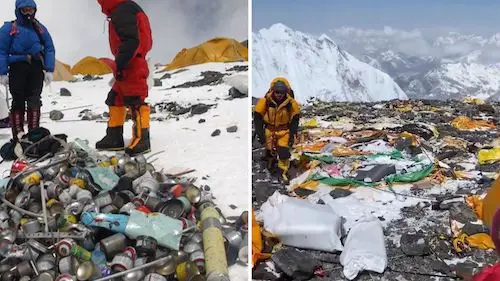
Even though each year, cleaning groups head up to Everest to clear tonnes of non-biodegradable items, including oxygen canisters, torn tents, plastics, and leftover mountaineering gear, they can’t keep up with the addition of trash on Mt. Everest each year.
With campaigns costing upwards of 23 million Nepalese rupees, approximately $206,540, according to Nepal’s Department of Tourism, it is not sustainable for the government to continue to invest heavily in the cleanup of the mountain. Moreover, as global warming continues to play its hand, more garbage as well as dead climbers are becoming visible. In 2017, climbers on an Everest cleanup mission discovered seven bodies along with 15 tons of human waste and additional trash.
Though the cleanup effort is crucial, it may only provide a temporary solution to the garbage issue. With fresh climbers attempting to climb the mountain every year, the abandoned waste piles are likely to grow further. The Government of Nepal has implemented a refundable $4,000 deposit requirement from each climber, provided they bring down a minimum of 8kgs (17.6 pounds) of trash while descending the mountain. However, considering the exorbitant cost of a “guided climb” up and down Everest, which can amount to $100,000, the $4,000 garbage tax may seem like a negligible sum.
Despite the challenges, many Sherpas, and expedition groups emphasized that failure is not an option in their mission to restore the mountain’s glory. Emphasizing that Everest is not merely the crown of the world but also a source of immense pride for the people of Nepal
The World’s Highest Landfills: Mount Everest Trash
In the Tibetan language, Mount Everest bears the name “Chomolungma” (also known as “Qomolangma” in Chinese), signifying “goddess mother of the world.” For the Sherpa people Everest holds deep spiritual significance, deserving utmost dignity and respect. In the past, it stood as a pristine landscape, but an influx of climbers and inadequate waste management practices have transformed it into a polluted mess with trash and 26,000 lbs of human excrement.
Nevertheless, there remains hope that organizations like the SPCC (Sagarmatha Pollution Control Committee), the Mount Everest Biogas Project, in collaboration with NGOs, climbers and the Nepali government, can work towards restoring the world’s highest peak to its former glory, removing much of the Mount Everest trash that pollutes the beautiful mountain.
